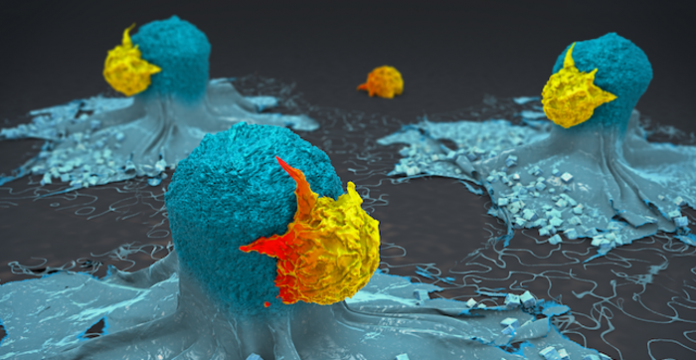
Researchers from The University of Texas MD Anderson Cancer Center provides new details of the diversity of T cell states and their role in the complex tumor microenvironment, information that shines a new light on understanding cancer immunotherapy. The new pan-cancer single-cell T cell atlas has pulled together 27 single-cell RNA seq datasets covering 16 cancer types and furthers the understanding the phenotypic states of T cells and how they influence therapy effectiveness as well as the potential for adverse events. The result of this work were published recently in Nature Medicine.
“This kind of large dataset and comprehensive pan-cancer analysis provides the opportunity to see things that aren’t visible when studying a single type of cancer or even a handful of cancer types,” said corresponding author Linghua Wang, M.D., Ph.D. associate professor of Genomic Medicine. “We hope these high-resolution maps, including the thoroughly characterized T cell states, are valuable resources for facilitating future T cell studies and biomarker discovery.”
A new discovery from the new study relates to T cell stress response state (TSTR), a group of T cells that have typically been overlooked or artifacts related to tissue dissociation. Using the breadth of data available from this new atlas, investigators showed that these cells are a unique group distinct from CD4+ or CD8+ T cell subsets, then validated their existence using a variety of spatial profiling methods.
According to the researchers, TSTR cells are T cells that have been stressed and become less effective at fighting cancer. Both TSTR cells and exhausted T cells don’t provide full function, but aren’t the same as TSTR cells follow a unique differentiation path that is distinct from exhausted T cells.
TSTR cells are characterized by high heat shock gene expression and are seen at significantly higher fractions in both CD4+ and CD8+ T cells following immune checkpoint blockade therapy—particularly in non-responders, suggesting they may play a role in immunotherapy resistance. Identifying TSTR as new, distinct T cell state helps further understanding of the intricate biology of cancer and provides a potential target for future therapies.
“The fact that these TSTR cells are found in many different types of tumors opens up a whole new world of possibilities that could have high translational potential,” Wang said. “Investigating the mechanistic causes of stress response in T cells, understanding how these stressed T cells are induced in the tumor microenvironment, and learning how to stop or reverse this TSTR state could catalyze the development of more effective therapeutic strategies that may bring the benefit of immunotherapy to more cancer patients.”
In total, after analysis of the broad data now integrated into the pan-cancer T cell atlas, the investigators were able to describe a total of 32 different T cells states while also identifying seven subpopulations within the CD4+ regulatory subset and point to the high complexity of the tumor microenvironment.
“There are still many questions left to answer,” Wang said. “One of the limitations of this study is we don’t have the corresponding T cell receptor data for most of the datasets analyzed. We are not sure what triggers the TSTR state, and we don’t know from which T cell subset(s) they originate. It also is unclear whether these TSTR cells are specific to tumor cells and how they communicate with and influence other cells within the tumor microenvironment.”
Researchers can now access this extensive data set via the Single-Cell Research Portal and the team also develop the TCellMap tool, which allows for the automatic annotation of T cells from a researcher’s datasets by aligning them with the T cell maps generated by the new study













